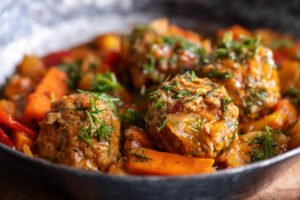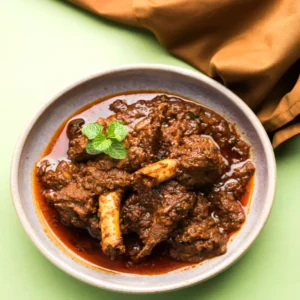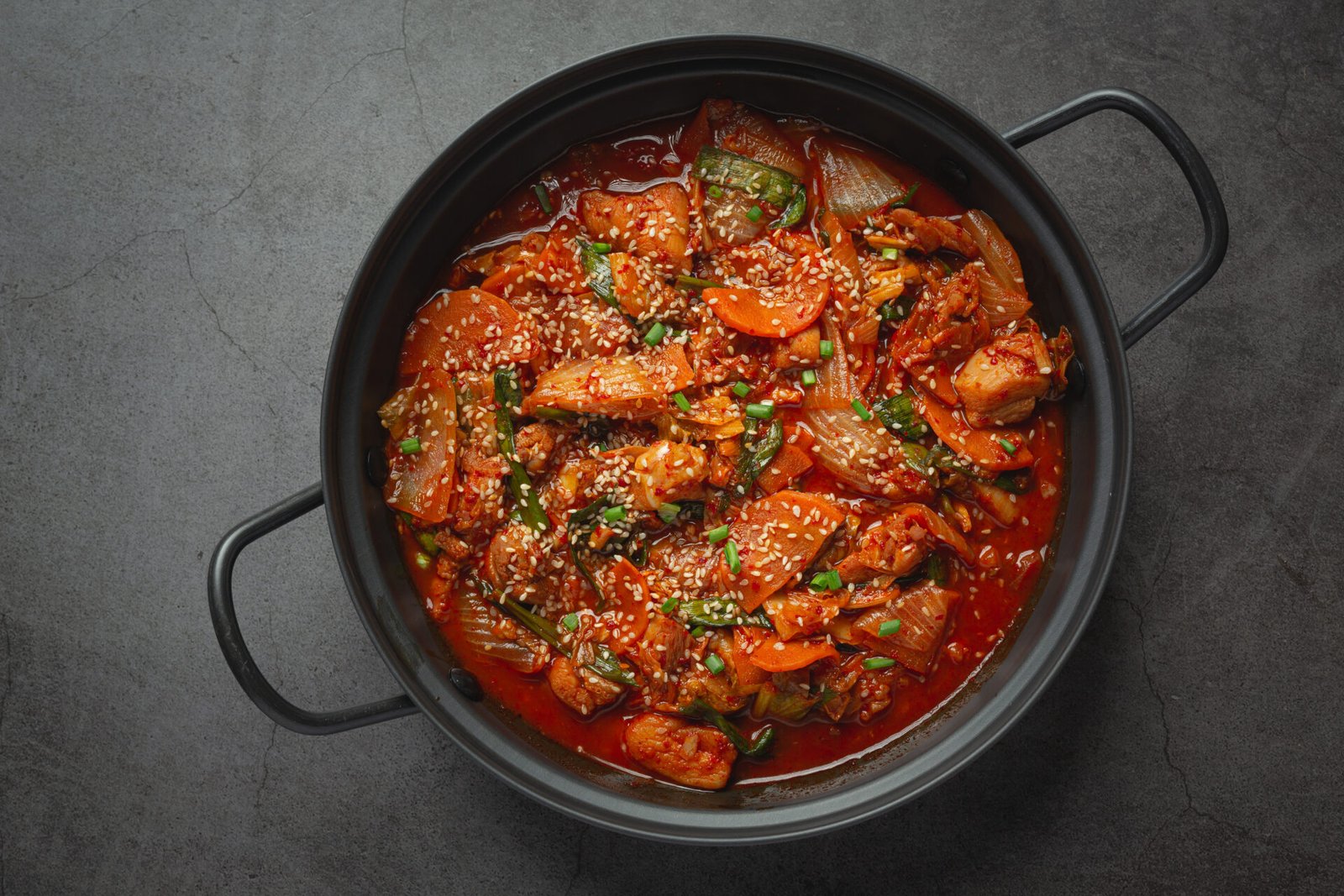Korma

Here’s a detailed recipe to make Korma, a flavorful and creamy curry dish:
Ingredients:
For the Marinade (Optional):
– 500 grams meat (chicken, lamb, or beef), cut into bite-sized pieces
– 1/2 cup plain yogurt
– 1 tablespoon ginger-garlic paste
– 1 teaspoon garam masala
– Salt to taste
For the Korma:
– 2 tablespoons ghee or vegetable oil
– 2 onions, finely chopped
– 2 tomatoes, finely chopped
– 1 tablespoon ginger-garlic paste
– 1/2 cup cashew nuts or blanched almonds
– 1/2 cup plain yogurt
– 1 teaspoon ground coriander
– 1 teaspoon ground cumin
– 1/2 teaspoon turmeric powder
– 1/2 teaspoon red chili powder (adjust to taste)
– 1/2 teaspoon ground cardamom
– 1/4 teaspoon ground cinnamon
– 1/4 teaspoon ground cloves
– Salt to taste
– 1 cup water or broth
– Fresh coriander leaves for garnish
– Sliced almonds or cashews for garnish (optional)
Instructions:
Step 1: Marinate the meat (optional):
1. In a bowl, combine meat with curd, ginger and garlic powder, garam masala and salt. Mix well to evenly coat the meat.
2. Simmer the covered meatballs for at least 30 minutes to allow the flavors to incorporate.
Step 2: Prepare the corma :
1. Heat the butter or vegetable oil in a large, deep skillet over medium heat.
2. Add the finely chopped onion and sauté until golden and caramelized, about 10-12 minutes.
3. Add the ginger and garlic powder and cook for 2-3 minutes until fragrant.
4. Add the diced tomatoes and cook until they break down and turn into a thick paste, about 5-7 minutes.
5. In a blender or food processor, blend cashews or ground almonds with plain yogurt until smooth. This gives the corm a creamy base.
6. Add the cashew-curd mixture to the pan and mix well with the onions and tomatoes.
7. Add ground coriander, ground cumin seeds, turmeric powder, red chilli powder, cardamom powder, cinnamon powder, ground cloves and salt to taste. Stir well to combine.
8. If using meatballs, add to the skillet and cook for 5-7 minutes until partially cooked and coated with the spice mixture.
9. Pour in water or broth to give the curry the desired consistency. Bring to a gentle simmer.
10. Cover the pan and cook the corm over medium heat for 20-25 minutes, or until the meat is tender and the flavors are cohesive.
11. After cooking, taste and adjust seasoning as necessary.
12. Garnish the corm with fresh oatmeal leaves, chopped almonds or cashews if desired.
13. Serve hot with fried rice, naan bread or bread.
Enjoy your homemade corm, a delicious and comforting treat perfect for any occasion.Meatballs with vegetables on pan on table. Closeup!
Calories in Korma:
Korma is a classic dish with a rich history and many benefits. Let’s delve into its history and broader benefits:
The History of Korma:
Ancient origins: The origins of Koram can be traced back to the Mughal period in the Indian subcontinent, especially in the 16th and 17th centuries It was believed that the Mughal rulers who were known for their sumptuous cuisine and their elaborate cooking was introduced.
Mughal Influence: Mughals from Central Asia brought a rich culinary heritage that combined Persian, Turkish and Indian influences Korma creamy chutneys and delicate spices epitomized the sophisticated gastronomy of the Mughal court.
Flexibility and flexibility: Corm has evolved over time, adapting to regional tastes and preferences across the Indian subcontinent. Different regions have developed their own varieties of Koram, using local ingredients and cooking techniques, and maintaining the essence of the sweet and savory elements of the dish
Benefits of korma:High-calorie products: Korma is usually made from a combination of meat (such as lamb, chicken, or beef), yogurt, nuts (such as cashews or almonds), and aromatic spices These products provide pure nutrition essential such as protein, vitamins and minerals, making korma into a healthy and satisfying meal .
Balanced flavours: Korma is known for its delicately balanced flavours, combining rich yoghurt or creamy cream with warm spices like cardamom, cinnamon and clove The result is a curry thick and aromatic that delights the taste buds and satisfies the palate.
Dietary benefits: Many spices used in Korme such as ginger, garlic and turmeric, are known for their digestive properties. They can promote digestion, reduce abdominal pain, and support overall gut health, and korma is not only delicious but also soothes the stomach
Cultural Significance: Korma has cultural significance in South Asian cuisine, especially in regions influenced by Mughal culinary traditions. It is usually served on special occasions, festivals and celebrations, symbolizing hospitality, abundance and excellent cooking.
Versatility: Korma is a versatile dish that can be adapted to different culinary tastes and preferences. While the traditional korma dishes feature meat, they can be made meatless and vegan with ingredients like paneer (Indian cottage cheese), vegetables and legumes

The importance of corm goes beyond its role as a delicacy; It holds cultural, social and culinary significance at various levels. Here is a breakdown of what it means:
1. Cultural Significance: Korma is deeply embedded in the culinary traditions of South Asia, especially in areas influenced by Mughal cuisine. It is often associated with special occasions, festivals and celebrations, symbolizing hospitality, generosity and abundance. Serving korma to guests is considered a sign of honor and respect, and reflects the host’s desire to create a memorable dining experience.
2. Historical Heritage: Korma has a rich historical heritage dating back to the Mughal era in the Indian subcontinent. It was loved by the Mughal emperors and royalty for its sweet taste and rich ingredients. Over time, korma has evolved, adapted to regional tastes and preferences, and become a favorite dish in South Asian culinary traditions
3. Cooking Excellence: Korma is known for its delicate balance of flavor and aroma, and slow cooking that combines creamy yogurt or cream with a blend of aromatic spices to bring it together, and provide it a sweet and thick curry that delights the senses . Mastering the art of korma making requires skill, patience and attention to detail, which are the hallmarks of culinary excellence.
4. Festive symbol: Korm is often served at festive gatherings, weddings, and other special occasions, where it plays an important role in festive feasts Its sweet taste and rich texture makes for dining of the experience is elevated and gives diners a sense of fun and celebration. Sharing corms with family and friends creates a sense of camaraderie and togetherness, strengthening social bonds and creating cherished memories.5. Versatility and flexibility: Corma’s versatility allows her to adapt to different food preferences and tastes. While the traditional korma dishes use meat, they can be made meatless and vegan with ingredients like cheese, vegetables or fruit. These changes ensure that korma remains a dish that can be enjoyed by people from different backgrounds and culinary traditions.
In conclusion, the significance of korma lies in its cultural significance, historical heritage, culinary efficiency, celebration and simultaneous nourishing function As a favorite food symbolizing the spirit of hospitality and food, korma holds a special place in the the world of the hearts and palates of the surrounding foodies

